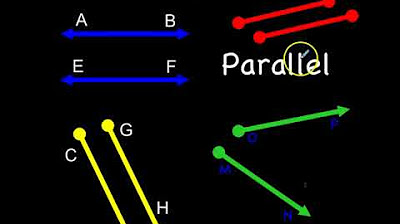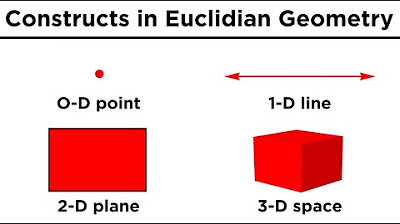PARALLEL, INTERSECTING & PERPENDICULAR LINES | GRADE 4
TLDRThis educational video script introduces students to the concepts of parallel, intersecting, and perpendicular lines. It explains that lines are infinite, one-dimensional figures with no thickness, and can be named using two points. The script teaches that parallel lines never meet, intersecting lines meet at a point, and perpendicular lines intersect to form a right angle. The lesson includes identifying these types of lines in a drawing of a house, with activities to engage students in recognizing examples.
Takeaways
- 📐 A line is defined as a one-dimensional figure that extends infinitely in both directions with no thickness.
- 📍 Lines can be named using two points on the line, such as line AB for points A and B.
- 🔍 There are different types of lines, including vertical, horizontal, and diagonal lines.
- 🌐 Parallel lines are lines that never intersect, no matter how far they are extended.
- 🔄 Examples of parallel lines in the script include lines MK and SB, as well as lines LO and GH.
- ✖️ Intersecting lines meet or cross each other at a certain point, creating a point of intersection.
- 🔺 Perpendicular lines are a special case of intersecting lines that form a right angle upon intersection.
- 🏠 The script uses a drawing of a house to illustrate the concepts of different types of lines.
- 🔍 The activity in the script encourages students to identify pairs of parallel, intersecting, and perpendicular lines from a given set.
- 📝 The lesson concludes with a summary of the concepts learned about lines and their relationships.
Q & A
What is the definition of a line according to the script?
-A line is a set of all points between and beyond two points, and it is a one-dimensional figure that is infinite in length, has no thickness, and extends endlessly in both directions.
How are lines named in geometry?
-Lines can be named using two points on the line. For example, if a line has points A and B, it can be called line AB.
What is a vertical line?
-A vertical line is a line that goes from top to bottom, meaning it is perpendicular to the horizontal direction.
What is a horizontal line?
-A horizontal line is a line that goes from right to left, meaning it is parallel to the ground or the base of a figure.
What is a diagonal line?
-A diagonal line is a line that slants in a particular direction, not necessarily vertical or horizontal, and is often used to connect opposite corners of a rectangle or square.
What are parallel lines?
-Parallel lines are lines that do not intersect or cross each other, even when extended in either direction.
Can you give an example of parallel lines from the script?
-Lines MK and SB, as well as lines LO and GH, are examples of parallel lines from the script.
What are intersecting lines?
-Intersecting lines are lines that meet or cross each other at a certain point.
What is the term used for the point where two lines intersect?
-The point where two lines intersect is called the point of intersection.
What are perpendicular lines?
-Perpendicular lines are intersecting lines that form a right angle as they cross each other.
Can you identify a pair of perpendicular lines from the script?
-Lines AB and EF are examples of perpendicular lines from the script, as they intersect and form a right angle.
What is the main activity the script suggests for students to do?
-The main activity suggested in the script is for students to identify pairs of parallel, intersecting, and perpendicular lines from a given set of lines.
Outlines
🏡 Introduction to Lines and Their Types
This paragraph introduces the concept of lines in geometry, focusing on their definitions and classifications. It starts by explaining what a line is, describing it as a one-dimensional figure that extends infinitely in both directions and has no thickness. The paragraph then delves into different types of lines such as vertical, horizontal, and diagonal lines. It further discusses pairs of lines, specifically parallel lines, which do not intersect even when extended, and provides examples of vertical, horizontal, and diagonal lines that can be parallel. The concept of intersecting lines is also introduced, where lines meet at a point, and the point of intersection is highlighted. Finally, the paragraph touches on perpendicular lines, which intersect to form a right angle, typically between a vertical and horizontal line.
📐 Identifying Parallel, Intersecting, and Perpendicular Lines
In this paragraph, the focus shifts to an activity where students are challenged to identify different types of line pairs from a given set. The activity starts by identifying parallel lines, which do not intersect, and examples such as lines 'city' and 'ef' are provided. The concept of intersecting lines is then explored, where lines meet at a point, and examples like lines 'gh' and 'cd' are given. Additionally, the paragraph discusses perpendicular lines, which intersect to form a right angle. Examples of perpendicular lines such as 'a b' and 'c', and 'a b' and 'e f' are provided, emphasizing the right angle formed at the intersection. The paragraph concludes with a summary of the key concepts learned in the lesson, reinforcing the understanding of parallel, intersecting, and perpendicular lines.
Mindmap
Keywords
💡Line
💡Parallel Lines
💡Intersecting Lines
💡Perpendicular Lines
💡Vertical Line
💡Horizontal Line
💡Diagonal Line
💡Point of Intersection
💡One-Dimensional Figure
💡Activity
💡Right Angle
Highlights
Introduction to the lesson on describing and drawing parallel, intersecting, and perpendicular lines.
Definition of a line as a one-dimensional figure that is infinite in length and has no thickness.
Explanation of how to name a line using two points on the line, such as line AB.
Different types of lines: vertical, horizontal, and diagonal.
Introduction of parallel lines that do not intersect even when extended.
Identification of pairs of parallel lines in the drawing, such as lines MK and SB.
Introduction of intersecting lines that meet at a certain point.
Identification of intersecting lines in the drawing, such as lines QD and ER.
Explanation of the point of intersection where lines meet.
Introduction of perpendicular lines that intersect and form a right angle.
Identification of perpendicular lines in the drawing, such as vertical line GH intersected by horizontal line AS.
Activity to identify pairs of parallel, intersecting, and perpendicular lines from the drawing.
Example of identifying parallel lines EF and CI in the activity.
Example of identifying intersecting lines GH and CD, and GH and EF in the activity.
Example of identifying perpendicular lines AB and CD, and AB and EF in the activity.
Summary of the lesson on the types of lines and their properties.
Transcripts
Browse More Related Video

Parallel, Intersection and Perpendicular Line

Parallel, Intersecting, and Perpendicular Lines | Geometry | Math with Mr. J

Parallel, Intersecting, & Perpendicular Lines

Basic Euclidean Geometry: Points, Lines, and Planes

Parallel & Perpendicular Lines, Alternate Interior & Exterior Angles, Transversals

Type of lines | Math for kids
5.0 / 5 (0 votes)
Thanks for rating: